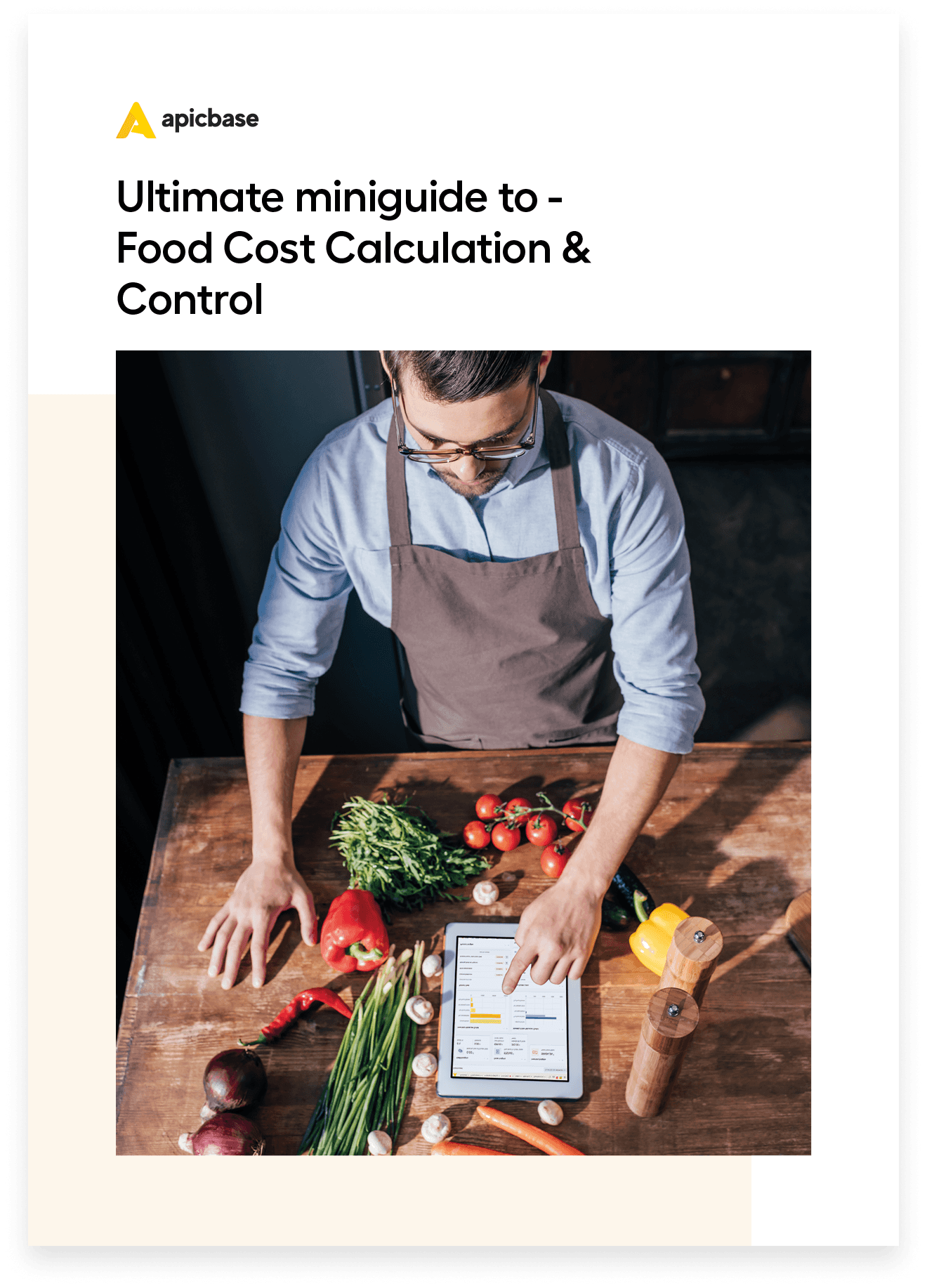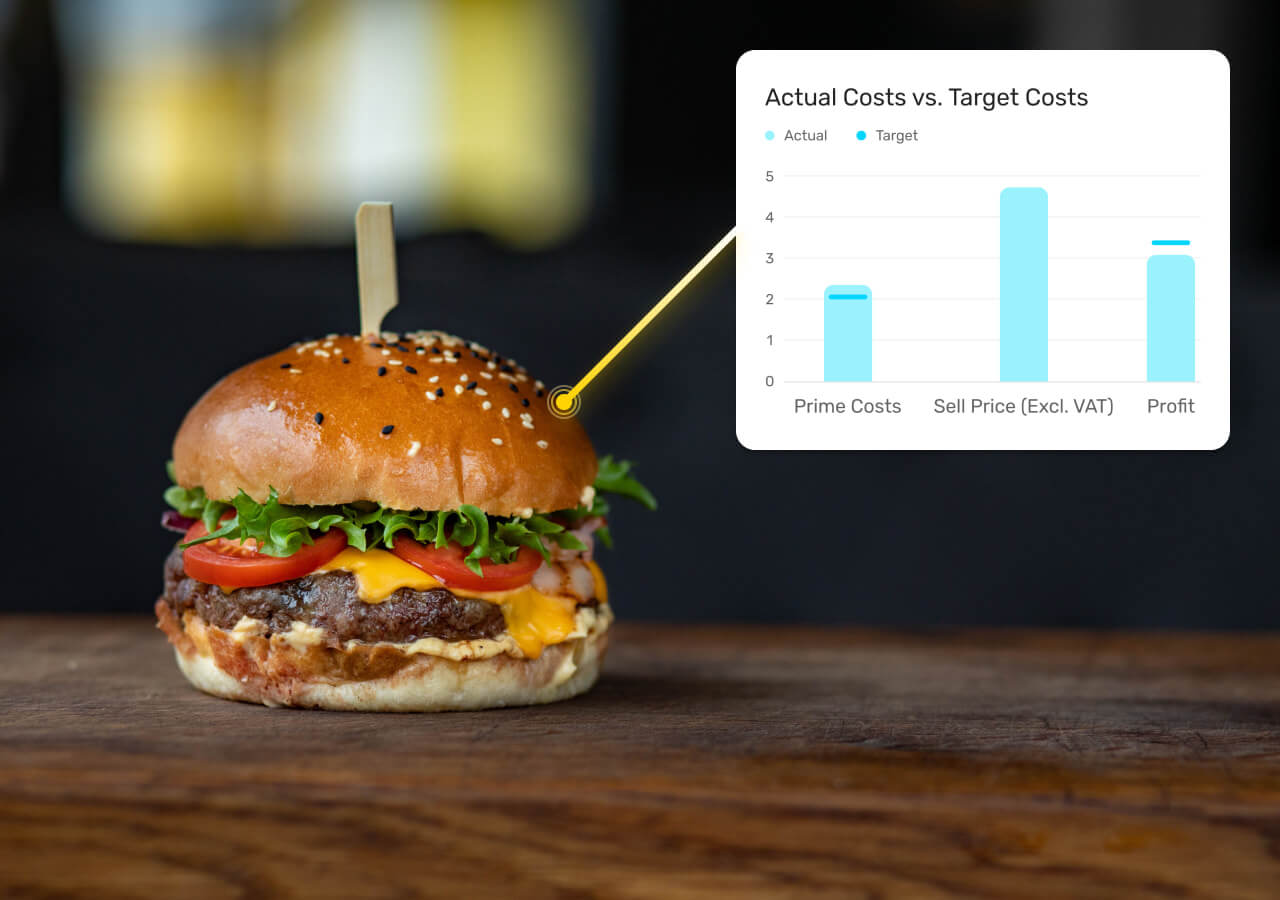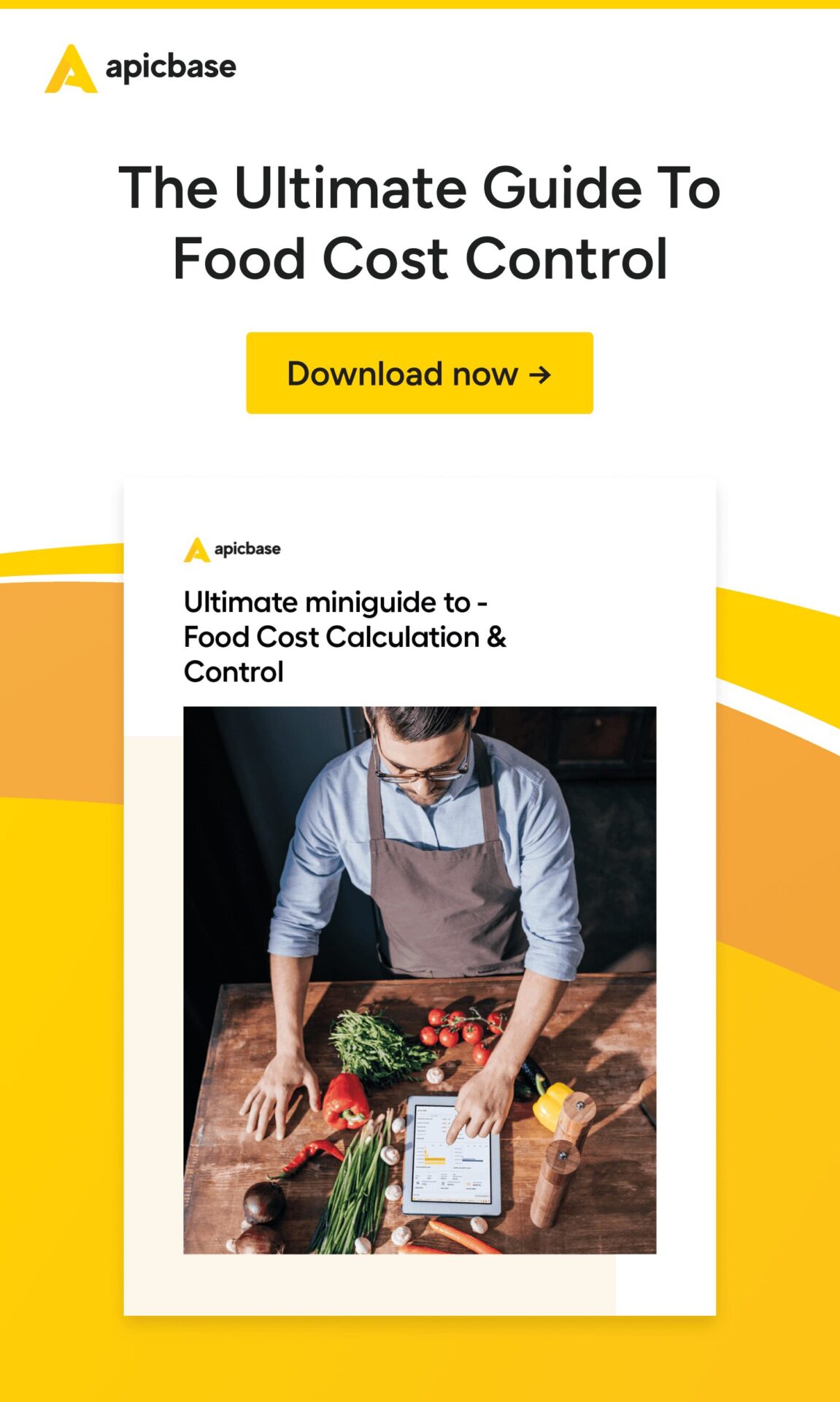Calculate food cost and boost profit; it is the first lesson anyone working in the restaurant business learns.
And rightly so.
The average restaurant food cost percentage is between 28% and 32% of total food sales, with peaks up to 45%.
That is enormous.
Nothing worse than working hard and not making any money, right? The good news is that food cost is a manageable cost.
Food cost control will save you money and boost profit without the need to generate extra revenue.
It all starts with some basic calculations and the right food cost formulas.
This post explains what the different food cost calculations are, which formulas to use and most importantly, how they help to keep costs of food under control.
There is no need to worry if it sounds complicated. We have included lots of examples to clarify everything.

Cut straight to the chase and download the FREE Guide to Food Cost Calculation and Control.
Keep the best food cost formulas close at hand.
Let’s kick things off with an illustration of how food cost impacts your G.O.P.
G.O.P. stands for Gross Operating Profit. It is the difference between turnover and operational costs, i.e. food cost, personnel costs and fixed costs.
In this example, food cost amounts up to 35% of turnover. See what happens to profit when you reduce the costs by only 5%.
Brace yourselves.

Yep, that’s right: profit grows by a whopping 58,5%.
Sounds too good to be true?
Nope, think about it, next to labour costs and rent, food costs are the highest expense of every food business. Even the smallest reduction of food cost percentage has a big impact on profit.
To make sure your business stays afloat, regular and accurate calculations of food costs are a must.
There are four main calculations to stay on top of:
- actual food cost,
- food cost percentage
- ideal food cost and
- food cost variance
Comparing these figures will help you adjust workflows and maximise profitability.
First of, actual food cost.
How to calculate actual food cost?
The actual food cost is the value by which your stock decreases over a given period. In other words, it is the depletion of inventory set against its value in money.
An accountant or controller might use the term ‘cost of goods sold‘. It means the same thing but also applies to other industries than the restaurant business. If you ever spot the abbreviation CoGS, you’ll know what it stands for.
Calculating your actual food cost requires accurate stock counts. There are many ways to go about them and quite frankly, most are tedious at best.
Nobody likes a stock count. It’s time-consuming, you need to do it often to extract extra juicy insights, and it’s a headache to streamline the data from the different counts.
These days technology helps you out. Stock counts can be done on a tablet so data won’t get lost.
If you are keen on saving time for your team and yourself, check our inventory module.
It lets you count stock digitally, integrates with your point-of-sales-system (POS) and automatically adjusts stock status and value. The software generates procurement suggestions and lets you send out orders directly to your favourite suppliers.
You’ll never have to write of unused stock again.
Anyway, back to food costing, to determine your actual food cost, you need to know five things:
- A specific time frame to investigate, say week 34
- The starting inventory value for that week
- Your purchases in that period
- The ending inventory value
- Turnover of week 34
At the start of week 34 you count everything in stock and multiply the items by its money value. Add everything up to know your starting inventory value.
Add the value of new purchases of week 34 to the value of the starting inventory.
From this, you subtract the value of the ending inventory. This is a stock count at the end of the period you are investigating.
The actual food cost formula is
Starting inventory value + Total value of new purchases – Ending inventory value = Actual food cost

Example of actual food cost calculation formula:
- Starting inventory = 10,000 pounds
- New purchases = 4,000 pounds
- Ending inventory = 11,000 pounds
- Actual food cost = 3,000 pounds
To see how well you perform compared to other restaurants or food services convert actual food cost to food cost percentage.
Keep in mind that the industry average is, depending on the type of business you are in, 28% – 32%.
Fast-casual restaurants generally find themselves on the lower end of the brackets, while high-end restaurants also tend to have a higher food cost.
The reason being that fast-casual restaurants have a scale advantage and more often than not have software helping them to minimise waste, keep stock lean and ordering efficient.
It is the same software that helps hotels and other multi-unit foodservice business keep costs down, quality up, and workforce happy.
How to calculate food cost percentage?
The food cost percentage formula is actual food cost divided by revenue for a specific period.

Example of food cost percentage formula:
We continue working on the food cost calculations for week 34. Suppose the revenue that week is 9,000 pounds.
That gives us the following calculation:
- Actual food cost = 3,000 pounds
- Revenue = 9,000 pounds
The result is: 3,000 / 9,000 = 0,33 = 33%
Food cost percentage for week 34 is 33%, which is high.
Keep reading to find out what the causes for high food cost are and what you can do to reduce food cost percentage.
Next on our list of important food cost formulas is ideal food cost.
What is ideal food cost?
The definition of ideal food cost is the cost expected for a specific period, based on recipes and the number of times each menu-item is sold.
Ideal food cost is also referred to as theoretical food cost or target food cost; theoretical because you don’t take into account actual inventory depletion.
It is called a target cost because it shows you exactly what you will spend if production is absolutely flawless, i.e. in an ideal world with no uncontrolled waste, no theft and perfect portioning.
Ideal food cost is the benchmark for actual food cost, and is used for menu pricing. It is also a prime element for calculating food cost variance and offers a baseline for menu engineering.
How to calculate ideal food cost?
To calculate the ideal food cost, first determine the food cost of each menu item.
Then multiply the cost of each menu item by the number of times it was sold in a given period of time. In other words, you multiply by the sales mix. Your POS system should be able to hand you the sales mix at the touch of a button.
Add the ideal cost of each menu item up to know the ideal food cost for this period.
Costing recipes can seem daunting if you have an extensive menu. Don’t let it frighten you. Accurate costing sheets will help you create profitable menus.
The ideal food cost percentage formula is
The ideal food cost percentage formula is ideal food cost divided by turnover.

Create a menu item food cost spreadsheet
A good way to start costing your recipes is to create a menu item food cost spreadsheet in Excel or Google Sheets.
It’s basic but effective.
On the worksheet each menu item’s ideal food cost is calculated based on the item’s ingredients, portions and current price.
Create five columns:
- Menu item with ingredients
- Unit
- Quantity used
- Unit cost
- Recipe cost

List the ingredients for each menu item and the quantity of each ingredient in detail on the worksheet. Use the same recipe unit, i.e., gram, volume measurement (tablespoon, cup, etc.) or number of pieces for each ingredient.
At the bottom of the column with your recipe cost you add everything up. The sum of the food cost of the individual menu-it is the ideal food cost of your menu.
If you are a spreadsheet wizard, make things easier for yourself by creating a separate list with all your ingredients, including current price and unit. Link these respectively to column one, two and four.
This way, when prices change (and they change a lot), you won’t have to update every single recipe sheet. Simply update the ingredients list to update all recipes with current supplier prices.

Cut straight to the chase and download the FREE Guide to Food Cost Calculation and Control.
Keep the best food cost formulas close at hand.
Calculate food cost variance to know if food cost is under control
Food cost variance is the difference between your ideal food cost percentage and actual food cost percentage. It is the ultimate test to check if food cost is under control — the closer to zero, the better.
Ideal and actual food cost percentages give an idea of how outlets are performing, but only a comparison of the two calculations shows if food cost is under control.
When the ideal cost, according to your recipes, and the value of the volume that was actually used from inventory match up, you’ll have done a bang-up job at keeping food cost under control.
This example illustrates how food cost variance impacts gross profit.
Meet Big Bang Bagels, a fast-casual restaurant chain with 24 outlets all over Europe and the UK.
Head Office asks management of the Brussels and Amsterdam branch to make an overview of their food cost percentages of week 34.
Check the break down of their numbers:
Big Bang Bagels Brussels:
- Actual food cost = 32,1% of turnover
- Ideal food cost = 29,5% of turnover
The deviation between the two is 2,6% of turnover.
Big Bang Bagels Amsterdam:
- Actual food cost = 32,8% of turnover
- Ideal food cost = 31,9% of turnover
Variance is only 0,9% of turnover.
Conclusion: the food cost in Amsterdam is higher, but management is doing a much better job at keeping the costs under control. Compared to Amsterdam, Brussels has 1,7% of avoidable food costs more (2,6% – 0,9% = 1,7%).
When you look at actual food costs alone, you might assume Brussels is doing a better job than Amsterdam, while in reality, the Brussels branch is accumulating unnecessary losses.
Why?
Let’s do the maths. Turnover for each branch is 1,000,000 pounds. The 1,7% of avoidable food cost for Brussels adds up to a loss of income of 17,000 pounds.
Whoops!
Imagine the food cost variance of half of the Big Bang Bagels units was as high as the one in Brussels?
Loss of profit would rise to a crazy 204,000 pounds (12 x 17,000).
Whoa!
Without proper food cost control, the head office would have never known gross profit was taking a cut because of poor food cost control in Brussels.
Careful monitoring of food costs, using the proper formulas, helped management to rethink Standard Operating Procedures and implement better workflows.
Are you trying to keep food costs at your restaurant or hotel chain down? We’ve listed our best food cost control tips in the article
9 ways to reduce food cost without giving in quality.
Start saving money right now.
What causes food cost variance?
If the actual food cost in your restaurant or hotel is higher than the ideal food cost (aka theoretical or target food cost), the reason can always be traced back to one or more of these seven causes:
- Waste or squandering
- Portion size
- Poor reception procedure
- Theft
- Error in the accounts
- Unrecorded sales
- Modified/wrong ideal food cost
Is your food cost variance growing? Discover practical tips and answers to close the gap between actual en ideal food cost in the post:
7 causes for variance between actual and ideal food cost.
John King of Pentahotel uses food cost software
The case study of John King is pretty spectacular. He is the executive chef of Pentahotels, a worldwide multi-outlet hotel business.
John switched to food cost calculation software to
– save time,
– optimise results,
– compare performance of the 26 hotels worldwide and
– improve Standard Operation Procedures.
Executive chefs, F&B managers and operations managers reading this will agree with him: getting the costing of recipes right and integrating the data into all kitchen operations takes up time and involves endless amounts of spreadsheets.
Just think of the many parts of your restaurant business that are affected by food cost:
- menu engineering,
- purchasing,
- pricing,
- stock, and
- kitchen management, to name a few.
Professional food costing software does all calculations automatically which makes profit control a lot more effective.
Helpful resource: Customer stories from Heavenly Desserts, Restaurant Company Europe, CitizenM and many more.
In conclusion
The importance of food cost control can hardly be underestimated and should be on top of every professional kitchen to-do list.
Doing all food cost calculations manually is one way to go about it, but if you are looking for ways to make kitchen operations more effective and less time-consuming, a switch to professional restaurant software might be just what you need.
To help you out we have compiled a list of 8 simple questions. If you answer yes to at least one them, it would be wise to consider your options.

Cut straight to the chase and download the FREE Guide to Food Cost Calculation and Control.
Keep the best food cost formulas close at hand.

